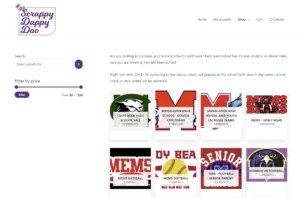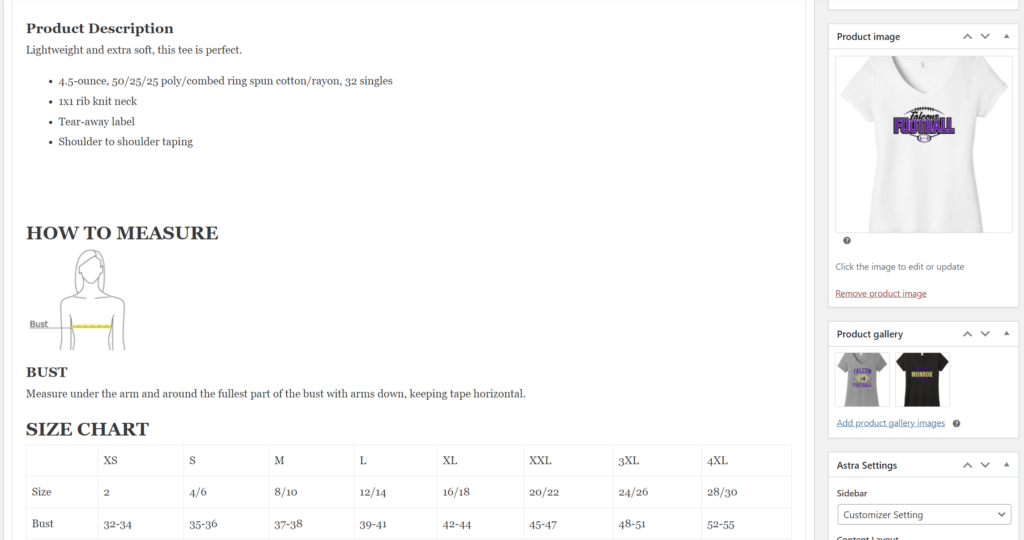
When it comes to webstores and e-commerce sites, sometimes the terminology can get a bit confusing. E-commerce sites are forward-facing sites that businesses or organizations use to sell products or services. The entity that created the site owns and runs the site, uses the business-specific branding and fulfills orders that come through the site.
A webstore, by contrast, is run by a garment decoration company on behalf of some other business or organization. The branding will be that of the client, not the garment decoration business. The
fulfillment will be by the garment dec- orator, but none of the recipients of the merchandise may be aware of the garment decoration company’s name, or that they even exist.
So why would a garment decoration shop choose to run a webstore, or multiple webstores? Especially if they’re already running an e-commerce website of their own.
Paperless trail
One reason was to upgrade the technology used to create fundraisers for clients.
David Kazler of Zone Z in Athens, Ohio, started using webstores for his customers because it eliminated tracking things on paper. “Prior to offering webstores our fundraisers were all paper form based,” he says. “Webstores automate the entire process from collecting the payment to blank order summaries to packing receipts.” Lisa Lemonick of Manalapan, New Jersey-based Scrappy Dappy Doo echoes Kazler’s comments, saying, “Most of our clients are school PTAs and teams. In our local school district, they are required to have their fundraising, especially spirit wear online, and not taking cash/checks. By going online, it also gives the end user the opportunity to purchase more with a credit card and get their points. We have found that since going online sales have increased.”

E-commerce sites do offer the same ability to go online, and to make purchases using credit cards, but the burden of creating, maintaining and tracking the orders is on the organization or business. They are also tasked with finding a company to create the merchandise and then have the responsibility of getting that merchandise to those who purchased it.
While this may be easily accomplished for some organizations, for many, handing off all the hassle to someone else is an attractive prospect. As Jennie Livezey, owner of Z Shirts Custom Printing of Shelbyville, Indiana, tells us, “They [customers] like that they don’t have to take orders, deal with collecting money, and making sure they have the correct sizes/ quantities.”
All that work can be offloaded to a garment decoration company, and the organization simply receives a paycheck for items sold.
Another difference between an e-commerce site and a webstore is that the setup for webstores can become easier over time. You can make the case that if one sets up enough websites, that setup should become easier too, but it really has to do with duplication. Too much duplication when setting up a website can get you banned by Google.
Webstores, on the other hand, can all operate off the same basic template, with only things like logos and product offerings being changed. Lemonick, of Scrappy Dappy Doo, says, “I have a format which I use on the backend, which makes creating them fairly easy and quick.”
Although, as Jennie Livesey from Z Shirts reminds us, the setup of a webstore can be complicated by customer needs and wants. As she says, “Some want a bunch of different designs on a bunch of different options. Others just want one or two designs on a few items, which takes considerably less time to create.”

Millions and billions
Convincing customers they don’t need a million items in their webstore, or a million different options for the same item, can be one challenge that shops that provide webstores face.
The team at Lewisville Lettering in Lewisville, Texas, discovered that the “biggest challenge is getting clients to understand that having seven or eight different designs doesn’t mean they are going to sell more product. It never fails that if a customer has eight designs, there will always be one or two that only have one or two pieces ordered.”
Any garment decoration shop, whether running webstores or their own e-commerce site, knows the pain of creating screens or designs, or ordering and stocking garments or hardgoods for an item that doesn’t sell well. Excess inventory and wasted time are never profitable for any business, regardless of how they’re selling online.
One of the advantages of offering web- stores to clients is that, because of the economies of scale that come with creating these types of sites, shops can create them more quickly and offer them to more customers, which then leads, if all goes well, to more profit.
Lewisville Lettering currently manages nine stores, with five more in the process of creation. Zone Z in Athens, Ohio, manages 20 stores at present. Kennewick, Washington-based Cottonclub Creations has 24 ongoing stores and two more in the works. Scrappy Dappy Doo currently runs 17 stores, as well as its own e-commerce website. Z Shirts Custom Printing runs nine, with five more in creation.
Once the process of creation has been set into place, creating the next store in line becomes that much easier and takes that much less time. And, of course, the greater the number of webstores a shop has running, the greater the revenue received.
Smooth setup
When setting up that first webstore, the template for all those that may fol- low, it’s a good idea to have a clear vision of what you want to offer. As the owner of Cottonclub Creations, Heather Cotton, notes, “Know what the service is that you want to offer and come up with a model you will use for all stores. For example, knowing what your terms of service will be, how many items you are willing to mock up and post, are you willing to ship or only do local teams, and figuring out what your baseline price will be for items in your stores.”

Having a solid set of policies in place will make dealing with prospective customers easy and will also provide the economies of scale that can make webstores so profitable. Knowing your policies and setting them ahead of time is also common sense for building a website, not necessarily for economies of scale, but so you can clearly communicate those policies to customers who visit the site to learn more about what your shop offers and how you do business.
When it comes to finding customers for the webstore model, don’t think the customer base is limited to just teams or schools. While team gear, or gear for booster clubs or school organizations, can sell well when offered through a webstore, many other types of businesses and organizations are also finding the webstore model works for them.
Zone Z runs nine government stores. There are corporate stores where employees can buy gear. Internet influencers or personalities who want to sell merchandise to their followers can also be a good source of work. Many people and organizations want the ability to sell merchandise and generate revenue, but either don’t have the knowledge or the capability, or even the desire, to make that happen themselves. Making the process easy and stress-free using a webstore can be a win-win both for the shop creating and running the store, and for the client.
Choosing a software solution is always a question, whether you’re building the first in a long line of webstores, or building your own e-commerce website. For websites, options like Shopify, Square, WooCommerce, Wix and Ecwid, along
with a host of others are probably the names that come to mind. When choosing a webstore, take some tips from our panel of experts … David Kasler of Zone Z recommends, “Choose a software vendor that provides after the purchase support.”
It is also wise not to assume that all your customers will know that creating webstores is a service you offer. As Jennie Livezey of Z Shirts Custom Printing notes: “Make sure you advertise this service so customers can take advantage of it.”
Once that advertising brings in new customers, you need a site that can handle the order volume generated. As Lisa Lemonick of Scrappy Dappy Doo advises, “Make sure your host can handle the volume of orders that are coming in, and make sure they have technical assistance to help you if something goes wrong once the store is open.”
Finally, there’s the question of what webstore software or program you might want to choose. You might, as Cottonclub Creations did, choose to run all your web- stores through your main store website, which in their case is Shopify.
Lewisville Lettering and Zone Z both use Webstores Simple, both for the customer and technical support and because the process of setting up new stores is simple and easy to use. Scrappy Dappy Doo uses Coolmodesigns.com, which is based upon Wordpress.
For Z Shirts Custom Printing, the webstore software of choice is InkSoft. As with choosing an e-commerce software, you want to make sure to find an option that provides adequate technical support, is robust enough to scale up as traffic and sales grow and provides solutions that allow for easy setup and management of stores.



